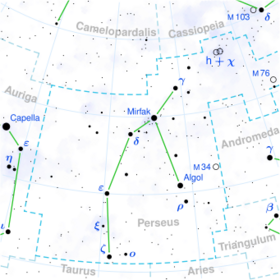Algol
Topic: Astronomy
 From HandWiki - Reading time: 12 min
From HandWiki - Reading time: 12 min
Algol /ˈælɡɒl/,[11] designated Beta Persei (β Persei, abbreviated Beta Per, β Per), known colloquially as the Demon Star, is a bright multiple star in the constellation of Perseus and one of the first non-nova variable stars to be discovered.
Algol is a three-star system, consisting of Beta Persei Aa1, Aa2, and Ab – in which the hot luminous primary β Persei Aa1 and the larger, but cooler and fainter, β Persei Aa2 regularly pass in front of each other, causing eclipses. Thus Algol's magnitude is usually near-constant at 2.1, but regularly dips to 3.4 every 2.86 days during the roughly 10-hour-long partial eclipses. The secondary eclipse when the brighter primary star occults the fainter secondary is very shallow and can only be detected photoelectrically.[12]
Algol gives its name to its class of eclipsing variable, known as Algol variables.
Observation history
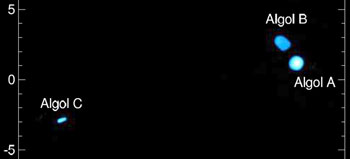
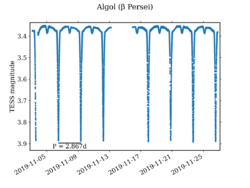
An ancient Egyptian calendar of lucky and unlucky days composed some 3,200 years ago is said to be the oldest historical documentation of the discovery of Algol.[13][14] [15]
The association of Algol with a demon-like creature (Gorgon in the Greek tradition, ghoul in the Arabic tradition) suggests that its variability was known long before the 17th century,[16] but there is still no indisputable evidence for this.[17] The Arabic astronomer al-Sufi said nothing about any variability of the star in his Book of Fixed Stars published c.964.[18]
The variability of Algol was noted in 1667 by Italian astronomer Geminiano Montanari,[19] but the periodic nature of its variations in brightness was not recognized until more than a century later, when the British amateur astronomer John Goodricke also proposed a mechanism for the star's variability.[20][21] In May 1783, he presented his findings to the Royal Society, suggesting that the periodic variability was caused by a dark body passing in front of the star (or else that the star itself has a darker region that is periodically turned toward the Earth). For his report he was awarded the Copley Medal.[22]
In 1881, the Harvard astronomer Edward Charles Pickering presented evidence that Algol was actually an eclipsing binary.[23] This was confirmed a few years later, in 1889, when the Potsdam astronomer Hermann Carl Vogel found periodic doppler shifts in the spectrum of Algol, inferring variations in the radial velocity of this binary system.[24] Thus Algol became one of the first known spectroscopic binaries. Joel Stebbins at the University of Illinois Observatory used an early selenium cell photometer to produce the first-ever photoelectric study of a variable star. The light curve revealed the second minimum and the reflection effect between the two stars.[25] Some difficulties in explaining the observed spectroscopic features led to the conjecture that a third star may be present in the system; four decades later this conjecture was found to be correct.[26]
System
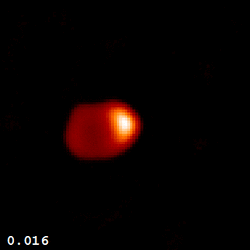
Algol is a multiple-star system with three confirmed and two suspected stellar components.[27] From the point of view of the Earth, Algol Aa1 and Algol Aa2 form an eclipsing binary because their orbital plane contains the line of sight to the Earth. The eclipsing binary pair is separated by only 0.062 astronomical units (au) from each other, whereas the third star in the system (Algol Ab) is at an average distance of 2.69 au from the pair, and the mutual orbital period of the trio is 681 Earth days. The total mass of the system is about 5.8 solar masses, and the mass ratios of Aa1, Aa2, and Ab are about 4.5 to 1 to 2.
The three components of the bright triple star used to be, and still sometimes are, referred to as β Per A, B, and C. The Washington Double Star Catalog lists them as Aa1, Aa2, and Ab, with two very faint stars B and C about one arcmin distant. A further five faint stars are also listed as companions.[28]
The close pair consists of a B8 main sequence star and a much less massive K0 subgiant, which is highly distorted by the more massive star. These two orbit every 2.9 days and undergo the eclipses that cause Algol to vary in brightness. The third star orbits these two every 680 days and is an A or F-type main sequence star. It has been classified as an Am star, but this is now considered doubtful.[5][29]
Studies of Algol led to the Algol paradox in the theory of stellar evolution: although components of a binary star form at the same time, and massive stars evolve much faster than the less massive stars, the more massive component Algol Aa1 is still in the main sequence, but the less massive Algol Aa2 is a subgiant star at a later evolutionary stage. The paradox can be solved by mass transfer: when the more massive star became a subgiant, it filled its Roche lobe, and most of the mass was transferred to the other star, which is still in the main sequence. In some binaries similar to Algol, a gas flow can be seen.[30] The gas flow between the primary and secondary stars in Algol has been imaged using Doppler Tomography.[31][32]
This system also exhibits x-ray and radio wave[33] flares. The x-ray flares are thought to be caused by the magnetic fields of the A and B components interacting with the mass transfer.[34] The radio-wave flares might be created by magnetic cycles similar to those of sunspots, but because the magnetic fields of these stars are up to ten times stronger than the field of the Sun, these radio flares are more powerful and more persistent.[35][36] The secondary component was identified as the radio emitting source in Algol using Very-long-baseline interferometry by Lestrade and co-authors.[4]
Magnetic activity cycles in the chromospherically active secondary component induce changes in its radius of gyration that have been linked to recurrent orbital period variations on the order of ΔP/P ≈ 10−5 via the Applegate mechanism.[37] Mass transfer between the components is small in the Algol system[38] but could be a significant source of period change in other Algol-type binaries.
Algol is about 92.8 light-years from the Sun, but about 7.3 million years ago it passed within 9.8 light-years of the Solar System[39] and its apparent magnitude was about −2.5, which is considerably brighter than the star Sirius is today. Because the total mass of the Algol system is about 5.8 solar masses, at the closest approach this might have given enough gravity to perturb the Oort cloud of the Solar System somewhat and hence increase the number of comets entering the inner Solar System. However, the actual increase in net cometary collisions is thought to have been quite small.[40]
Names
Beta Persei is the star's Bayer designation.
The official name Algol
The name Algol derives from Arabic رأس الغول raʾs al-ghūl : head (raʾs) of the ogre (al-ghūl) (see "ghoul").[41] The English name Demon Star was taken from the Arabic name.[42] In 2016, the International Astronomical Union organized a Working Group on Star Names (WGSN)[43] to catalog and standardize proper names for stars. The WGSN's first bulletin of July 2016[44] included a table of the first two batches of names approved by the WGSN; which included Algol for this star. It is so entered on the IAU Catalog of Star Names.[45]
Ghost and demon star
In Hebrew folklore, Algol was called Rōsh ha Sāṭān or "Satan's Head", as stated by Edmund Chilmead, who called it "Divels head" or Rosch hassatan. A Latin name for Algol from the 16th century was Caput Larvae or "the Spectre's Head".[42] Hipparchus and Pliny made this a separate, though connected, constellation.[42]
First star of Medusa's head
Earlier the name of the constellation Perseus was Perseus and Medusa's Head where an asterism representing the head of Medusa after Perseus has cut it off already known in ancient Rome. [46] Medusa is a gorgon so the star is also called Gorgonea Prima meaning the first star of the gorgon.[42]
Chinese names
In Chinese, 大陵 (Dà Líng), meaning Mausoleum, refers to an asterism consisting of β Persei, 9 Persei, τ Persei, ι Persei, κ Persei, ρ Persei, 16 Persei and 12 Persei. Consequently, the Chinese name for β Persei itself is 大陵五 (Dà Líng wu, English: The Fifth Star of Mausoleum.).[47] According to R.H. Allen the star bore the grim name of Tseih She 積屍 (Zhi Shī), meaning "Piled up Corpses"[42] but this appears to be a misidentification, and Dié Shī is correctly π Persei, which is inside the Mausoleum.[48]
Cultural significance
The constellation Perseus and Algol, the Bright Star in the Gorgon's head | |
|---|---|
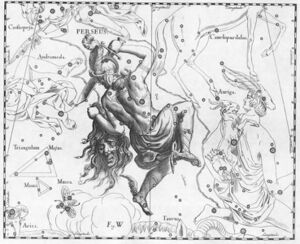 Johannes Hevelius, Uranographia, 1690 |
Historically, the star has received a strong association with bloody violence across a wide variety of cultures. In the Tetrabiblos, the 2nd-century astrological text of the Alexandrian astronomer Ptolemy, Algol is referred to as "the Gorgon of Perseus" and associated with death by decapitation: a theme which mirrors the myth of the hero Perseus's victory over the snake-haired Gorgon Medusa.[49] In the astrology of fixed stars, Algol is considered one of the unluckiest stars in the sky,[42] and was listed as one of the 15 Behenian stars.[50]
See also
- Jaana Toivari-Viitala, egyptologist who contributed to understanding Ancient Egypt and the star
References
- ↑ 1.0 1.1 1.2 1.3 1.4 Van Leeuwen, F. (2007). "Validation of the new Hipparcos reduction". Astronomy and Astrophysics 474 (2): 653–664. doi:10.1051/0004-6361:20078357. Bibcode: 2007A&A...474..653V.
- ↑ 2.0 2.1 2.2 Ducati, J. R. (2002). "VizieR Online Data Catalog: Catalogue of Stellar Photometry in Johnson's 11-color system". CDS/ADC Collection of Electronic Catalogues 2237: 0. Bibcode: 2002yCat.2237....0D.
- ↑ 3.0 3.1 Samus, N. N. et al. (2009). "VizieR Online Data Catalog: General Catalogue of Variable Stars (Samus+ 2007–2013)". VizieR On-line Data Catalog: B/GCVS. Originally Published in: 2009yCat....102025S 1: 02025. Bibcode: 2009yCat....102025S.
- ↑ 4.0 4.1 4.2 Lestrade, Jean-Francois; Phillips, Robert B.; Hodges, Mark W.; Preston, Robert A. (June 1993). "VLBI astrometric identification of the radio emitting region in Algol and determination of the orientation of the close binary" (in en). The Astrophysical Journal 410: 808. doi:10.1086/172798. ISSN 0004-637X. Bibcode: 1993ApJ...410..808L.
- ↑ 5.0 5.1 Frank, M. G.; Whelan, D. G.; Junginger, J. C. (2022). "Spectral Classification of Algol C". Journal of the American Association of Variable Star Observers (Jaavso) 50 (1): 123. Bibcode: 2022JAVSO..50..123F.
- ↑ Fletcher, Emery S. (1964). "Spectrophotometry of Algol". The Astronomical Journal 69: 357. doi:10.1086/109284. Bibcode: 1964AJ.....69..357F.
- ↑ 7.0 7.1 7.2 7.3 7.4 7.5 7.6 Soderhjelm, S. (1980). "Geometry and dynamics of the Algol system". Astronomy and Astrophysics 89 (1–2): 100. Bibcode: 1980A&A....89..100S.
- ↑ 8.0 8.1 8.2 8.3 8.4 8.5 8.6 8.7 Baron, F.; Monnier, J. D.; Pedretti, E.; Zhao, M.; Schaefer, G.; Parks, R.; Che, X.; Thureau, N. et al. (2012). "Imaging the Algol Triple System in the H Band with the CHARA Interferometer". The Astrophysical Journal 752 (1): 20. doi:10.1088/0004-637X/752/1/20. Bibcode: 2012ApJ...752...20B.
- ↑ 9.0 9.1 9.2 9.3 9.4 9.5 Zavala, R. T.; Hummel, C. A.; Boboltz, D. A.; Ojha, R.; Shaffer, D. B.; Tycner, C.; Richards, M. T.; Hutter, D. J. (2010). "The Algol Triple System Spatially Resolved at Optical Wavelengths". The Astrophysical Journal Letters 715 (1): L44–L48. doi:10.1088/2041-8205/715/1/L44. Bibcode: 2010ApJ...715L..44Z.
- ↑ Tomkin, J.; Huisong, T. (1985). "The rotation of the primary of Algol". Publications of the Astronomical Society of the Pacific 97: 51. doi:10.1086/131493. Bibcode: 1985PASP...97...51T.
- ↑ Algol (3rd ed.), Oxford University Press, September 2005, http://oed.com/search?searchType=dictionary&q=Algol (Subscription or UK public library membership required.)
- ↑ "Beta Persei (Algol)". AAVSO. January 1999. http://www.aavso.org/vstar/vsots/0199.shtml.
- ↑ Porceddu, S.; Jetsu, L.; Lyytinen, J.; Kajatkari, P.; Lehtinen, J.; Markkanen, T. et al. (2008). "Evidence of Periodicity in Ancient Egyptian Calendars of Lucky and Unlucky Days". Cambridge Archaeological Journal 18 (3): 327–339. doi:10.1017/S0959774308000395. Bibcode: 2008CArcJ..18..327P.
- ↑ Jetsu, L.; Porceddu, S.; Lyytinen, J.; Kajatkari, P.; Lehtinen, J.; Markkanen, T. et al. (2013). "Did the Ancient Egyptians Record the Period of the Eclipsing Binary Algol - The Raging One?". The Astrophysical Journal 773 (1): A1 (14pp). doi:10.1088/0004-637X/773/1/1. Bibcode: 2013ApJ...773....1J.
- ↑ Jetsu, L.; Porceddu, S. (2015). "Shifting Milestones of Natural Sciences: The Ancient Egyptian Discovery of Algol's Period Confirmed". PLOS ONE 10 (12): e.0144140 (23pp). doi:10.1371/journal.pone.0144140. PMID 26679699. Bibcode: 2015PLoSO..1044140J.
- ↑ Wilk, Stephen R. (1996). "Mythological Evidence for Ancient Observations of Variable Stars". The Journal of the American Association of Variable Star Observers 24 (2): 129–33. Bibcode: 1996JAVSO..24..129W.
- ↑ Davis, G.A. (1957). "Why did the Arabs Call Beta Persei "al-Ghul"?". Sky and Telescope 16: 177. Bibcode: 1957S&T....16..177D.
- ↑ "Ian Ridpath's Star Tales – Perseus". http://www.ianridpath.com/startales/perseus.html#algol.
- ↑ G. Montanari, "Sopra la sparizione d'alcune stelle et altre novità celesti", in: Prose de Signori Accademici Gelati di Bologna (Bologna: Manolessi, 1671), pp. 369–92 (Google books).
- ↑ ADS O.J. Eggen,"An Eighteenth Century Discussion of Algol", The Observatory, 77 (1957), 191–197.
- ↑ Goodricke, John (1783-01-01). "XXVI. A series of observations on, and a discovery of, the period of the variation of the light of the bright star in the head of medusa, called algol. In a letter from John Goodricke, Esq. to the Rev. Anthony Shepherd, D. D. F. R. S. and Plumian Professor at Cambridge". Philosophical Transactions of the Royal Society of London 73: 474–482. doi:10.1098/rstl.1783.0027.
- ↑ "John Goodricke, The Discovery of the Occultating Variable Stars". 6 August 2003. http://www.surveyor.in-berlin.de/himmel/Bios/Goodricke-e.html.
- ↑ Pickering, Edward C. (1881). "Dimensions of the Fixed Stars, with especial reference to Binaries and Variables of the Algol type". Astronomical Register 50 (1–2): 253–56. Bibcode: 1881AReg...19..253..
- ↑ A. H. Batten (1989). "Two Centuries of Study of Algol Systems". Space Science Reviews 50 (1/2): 1–8. doi:10.1007/BF00215914. Bibcode: 1989SSRv...50....1B.
- ↑ J. Stebbins (1910). "The Measurement of the Light of Stars with a Selenium Photometer with an Application to the Variation of Algol". Astrophysical Journal 32: 185–214. doi:10.1086/141796. Bibcode: 1910ApJ....32..185S.
- ↑ Meltzer, Alan S., A "Spectroscopic Investigation of Algol". Astrophysical Journal, vol. 125, (1957), p.359, BibCode:1957ApJ...125..359M
- ↑ Jetsu, L. (2021). "Say Hello to Algol's New Companion Candidates". The Astrophysical Journal 920 (2): 137. doi:10.3847/1538-4357/ac1351. Bibcode: 2021ApJ...920..137J.
- ↑ Mason, Brian D.; Wycoff, Gary L.; Hartkopf, William I.; Douglass, Geoffrey G.; Worley, Charles E. (2001). "The 2001 US Naval Observatory Double Star CD-ROM. I. The Washington Double Star Catalog". The Astronomical Journal 122 (6): 3466–3471. doi:10.1086/323920. Bibcode: 2001AJ....122.3466M.
- ↑ Renson, P.; Manfroid, J. (May 2009). "Catalogue of Ap, HgMn and Am stars". Astronomy and Astrophysics 498 (3): 961–966. doi:10.1051/0004-6361/200810788. Bibcode: 2009A&A...498..961R.
- ↑ Pustylnik, Izold (1995). "On Accretion Component of the Flare Activity in Algol". Baltic Astronomy 4 (1–2): 64–78. doi:10.1515/astro-1995-0106. Bibcode: 1995BaltA...4...64P.
- ↑ Richards, Mercedes T.; Albright, Geary E.; Bowles, Larissa M. (January 1995). "Doppler tomography of the gas stream in short-period Algol binaries" (in en). The Astrophysical Journal 438: L103. doi:10.1086/187726. ISSN 0004-637X. Bibcode: 1995ApJ...438L.103R.
- ↑ Richards, Mercedes T.; Agafonov, Michail I.; Sharova, Olga I. (2012-11-20). "NEW EVIDENCE OF MAGNETIC INTERACTIONS BETWEEN STARS FROM THREE-DIMENSIONAL DOPPLER TOMOGRAPHY OF ALGOL BINARIES: β PER AND RS VUL". The Astrophysical Journal 760 (1): 8. doi:10.1088/0004-637X/760/1/8. ISSN 0004-637X. Bibcode: 2012ApJ...760....8R.
- ↑ Wade, C. M.; Hjellming, R. M. (February 4, 1972). "Radio Stars Beta Persei and Beta Lyrae" (in en). Nature 235 (5336): 270–271. doi:10.1038/235270a0. ISSN 0028-0836. Bibcode: 1972Natur.235..270W.
- ↑ M.J. Sarna; S.K. Yerli; A.G. Muslimov (1998). "Magnetic Activity and Evolution of Algol-type Stars - II". Monthly Notices of the Royal Astronomical Society 297 (3): 760–68. doi:10.1046/j.1365-8711.1998.01539.x. Bibcode: 1998MNRAS.297..760S.
- ↑ Blue, Charles E. (3 June 2002). "Binary Stars "Flare" With Predictable Cycles, Analysis of Radio Observations Reveals". National Radio Astronomy Observatory. http://www.nrao.edu/pr/2002/algol/.
- ↑ Richards, Mercedes T.; Waltman, Elizabeth B.; Ghigo, Frank D.; Richards, Donald St. P. (August 2003). "Statistical Analysis of 5 Year Continuous Radio Flare Data from β Persei, V711 Tauri, δ Librae, and UX Arietis" (in en). The Astrophysical Journal Supplement Series 147 (2): 337–361. doi:10.1086/375835. ISSN 0067-0049. Bibcode: 2003ApJS..147..337R.
- ↑ Applegate, James H. (1992). "A mechanism for orbital period modulation in close binaries". Astrophysical Journal, Part 1 385: 621–629. doi:10.1086/170967. Bibcode: 1992ApJ...385..621A.
- ↑ Wecht, Kristen (2006). Determination of Mass Loss and Mass Transfer Rates of Algol (Beta Persei) from the Analysis of Absorption Lines in the UV Spectra Obtained by the IUE Satellite (Thesis). arXiv:astro-ph/0611855. Bibcode:2006PhDT........10W.
- ↑ Garcia-Sanchez, J.; Preston, R. A.; Jones, D. L.; Lestrade, J.-F.; Weissman, P. R.; Latham, D. W. (25 August 1997). "A Search for Stars Passing Close to the Sun". Kyoto, Japan: IAU. Bibcode: 1997IAUJD..14E..51G.
- ↑ J. García-Sánchez; R.A. Preston; D.L. Jones; P.R. Weissman (1999). "Stellar Encounters with the Oort Cloud Based on Hipparcos Data". The Astronomical Journal 117 (2): 1042–55. doi:10.1086/300723. Bibcode: 1999AJ....117.1042G.
- ↑ P. Kunitzsch & T. Smart, Short Guide to Modern Star Names and Their Derivations (Wiesbaden: Otto Harrassowitz, 1986), p 49.
- ↑ 42.0 42.1 42.2 42.3 42.4 42.5 Allen, R. H. (1963). Star Names: Their Lore and Meaning (Reprint ed.). New York: Dover Publications Inc.. p. 331. ISBN 978-0-486-21079-7. https://archive.org/details/starnamestheirlo00alle/page/331.
- ↑ "IAU Working Group on Star Names (WGSN)". https://www.iau.org/science/scientific_bodies/working_groups/280/.
- ↑ "Bulletin of the IAU Working Group on Star Names, No. 1". http://www.pas.rochester.edu/~emamajek/WGSN/WGSN_bulletin1.pdf.
- ↑ "IAU Catalog of Star Names". http://www.pas.rochester.edu/~emamajek/WGSN/IAU-CSN.txt.
- ↑ "Marcus Vitruvius Pollio: de Architectura, Book IX". https://penelope.uchicago.edu/Thayer/E/Roman/Texts/Vitruvius/9*.html#4.2.
- ↑ (in Chinese) AEEA (Activities of Exhibition and Education in Astronomy) 天文教育資訊網2006年7月11日
- ↑ "Ian Ridpath's Star Tales – Perseus". http://www.ianridpath.com/startales/perseus.htm#chinese.
- ↑ Robbins, Frank E. (ed.) 1940. Ptolemy: Tetrabiblos. Cambridge, Massachusetts: Harvard University Press (Loeb Classical Library). ISBN:0-674-99479-5, IV.9, p.435.
- ↑ Henry Cornelius Agrippa (1898). Three Books of Occult Philosophy. https://archive.org/details/threebooksofoccu00agri. Lyons, 1531/33. Llewellyn reprint, 1993; tr. J. Freake (1651), ed. D. Tyson, p.411.
External links
| Wikisource has the text of the 1911 Encyclopædia Britannica article Algol. |
- "Algol 3". SolStation. http://www.solstation.com/stars2/algol3.htm.
- "4C02517". ARICNS. 4 March 1998. http://www.ari.uni-heidelberg.de/aricns/cnspages/4c02517.htm.
- "Algol". Alcyone ephemeris. http://www.alcyone.de/SIT/mainstars/SIT000666.htm.
- Bezza, Giuseppe. "Al-ghûl, the ogre". Cielo e Terra. http://www.cieloeterra.it/eng/eng.articoli.algol/eng.algol.html.
Coordinates: ![]() 03h 08m 10.1315s, +40° 57′ 20.332″
03h 08m 10.1315s, +40° 57′ 20.332″
 |
 KSF
KSF